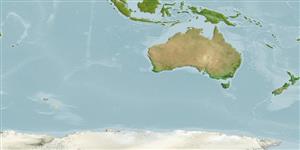Preferred temperature (Ref.
123201): -0.2 - 0.9, mean 0.2 °C (based on 5 cells).
Phylogenetic diversity index (Ref.
82804): PD
50 = 0.5156 [Uniqueness, from 0.5 = low to 2.0 = high].
Bayesian length-weight: a=0.00513 (0.00247 - 0.01065), b=3.13 (2.95 - 3.31), in cm total length, based on LWR estimates for this (Sub)family-body shape (Ref.
93245).
Niveau trophique (Ref.
69278): 3.2 ±0.43 se; based on food items.
Résilience (Ref.
120179): Milieu, temps minimum de doublement de population : 1,4 à 4,4 années (Fec = 193).
Fishing Vulnerability (Ref.
59153): Low vulnerability (10 of 100).
Nutrients (Ref.
124155): Calcium = 69.5 [37.5, 172.9] mg/100g; Iron = 0.598 [0.241, 1.230] mg/100g; Protein = 17 [16, 18] %; Omega3 = 0.272 [0.127, 0.564] g/100g; Selenium = 14.7 [5.3, 35.8] μg/100g; VitaminA = 17.4 [3.4, 83.8] μg/100g; Zinc = 0.755 [0.483, 1.164] mg/100g (wet weight);
